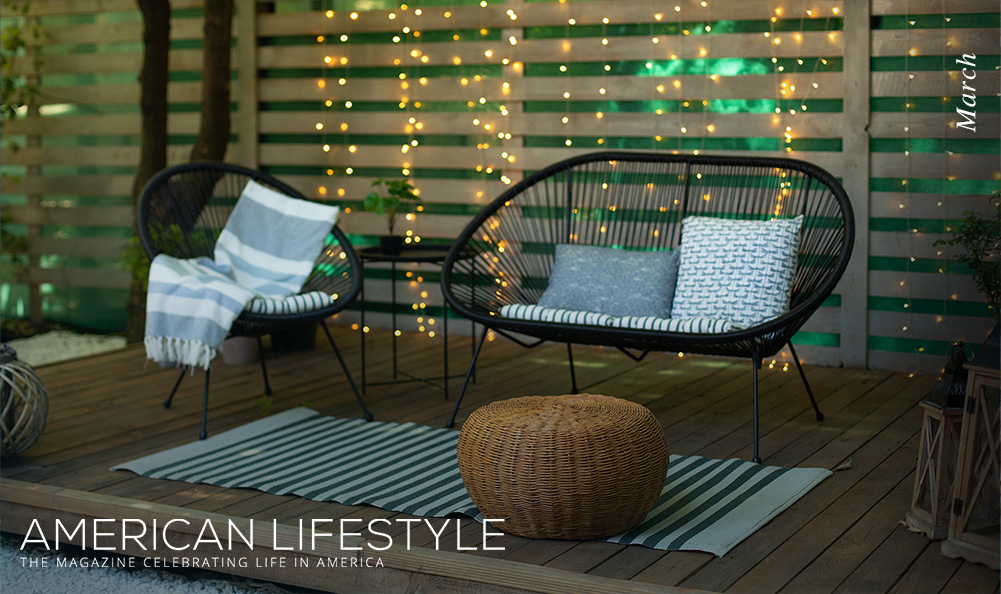Dear Friends,
Spring is quickly approaching, and with it comes new opportunities to refresh your life. This issue of American Lifestyle is here to help you embrace all the season has to offer with tips for revitalizing your home’s outdoor spaces, a look at an inspirational home decor company, two tasty recipes the whole family will love, and a road trip idea for every golf enthusiast.
Because winter often means more hours inside, spring is a great time to get out and enjoy the beauty of nature. To help you make the most of your outdoor spaces this season, this issue offers simple tips for transitioning your home from winter to spring.
Woodworking is a passion of Hadeel Khatar and her husband, which led them to start Four Rivers Studio in 2020. Inspired by natural materials and color combinations, they create custom wood pieces that add beauty to any room. Be sure to check out the article inside for a behind-the-scenes look at all the company has to offer.
With the refreshing season ahead, it’s a good time to mix up your meal rotation and try something new. This issue features two simple yet scrumptious recipes for a chicken avocado salad and pineapple whip that are sure to be a hit with your loved ones.
Alabama may not be at the top of your list for a spring trip, but it offers some of the most beautiful golf courses in the country. With twenty-six courses at eleven sites across the state, the Robert Trent Jones Golf Trail is a golfer’s dream come true. Inside you’ll find a guide that explains what makes each course unique.
Here’s to a successful start to spring! As always, it’s a pleasure to send you this magazine.
Kind Regards,
Anne Hitch
The Edgewater Group of SC, LLC
Spring will soon be in full bloom, so it’s time to start thinking about how you’re going to prepare your home for the season. While we tend to spend more hours inside during winter, spring is a great time to get outside and enjoy our outdoor spaces. Here are some tips to help you prepare your home’s exterior for the season ahead.
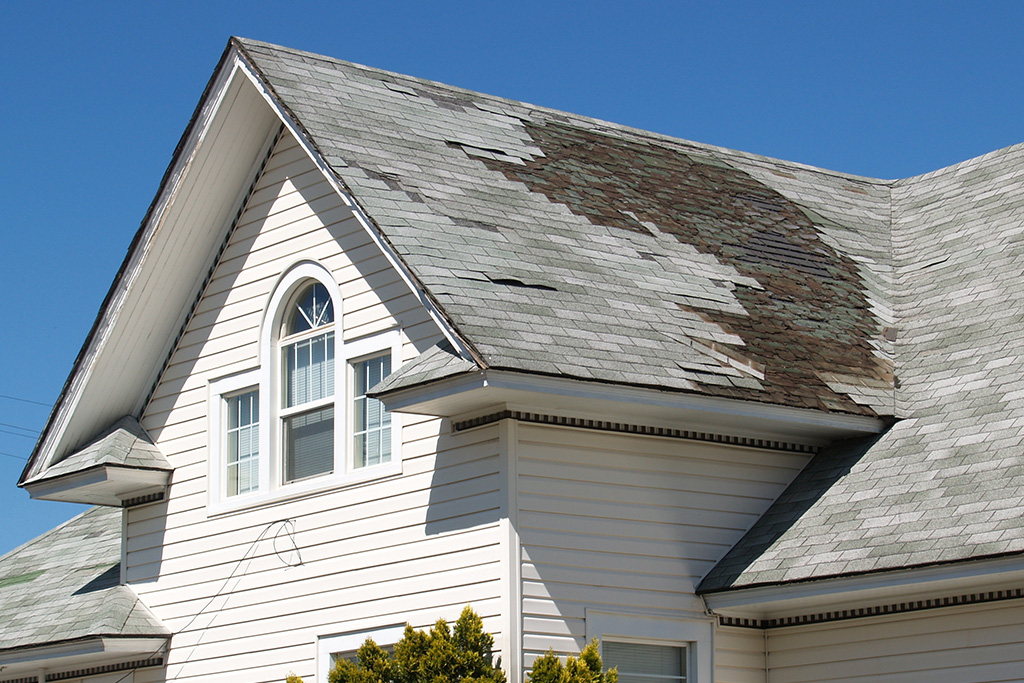
Winter often brings lower temperatures, and many people around the country face ice and snow. While this can make for a fun winter day, freezing temps aren’t always easy on your home. If you had a chilly winter, be sure to get outside and walk around the perimeter of your house, checking for any gaps in your foundation, loose roof shingles, debris in your gutters, gaps in the seals of your windows and doors, or cracks in your outdoor faucets and lawn sprinklers. You’ll want to repair or replace anything damaged as soon as possible to ensure that your home is in tip-top shape for spring.

Spring is also a great time to declutter and organize your storage areas. Take some time to clean out your garage and shed, removing any debris left over from the winter months and arranging your tools for the season ahead. Go through your gardening and lawn equipment, first checking to make sure everything is still in proper working condition and then organizing it all based on what you use most frequently. You’ll need to access this equipment more in spring, so save yourself the headache down the road by making these items easier to find now.

We’ve all heard the saying, but May flowers don’t appear just because of April showers. Your garden is probably in need of some TLC after the winter months, and March is often a great time to perform this maintenance. Once the temperature warms up, you can go through and remove any winter protection from your garden, pull visible weeds that could prevent your plants from reaching their full potential, rake away dead leaves and foliage, prune branches that suffered winter damage, and fertilize your soil. While this process can be time consuming, you’ll soon be able to reap the beautiful rewards of your efforts.
If you’re looking to add new plants to your yard this year, use the Farmer’s Almanac to make a planting schedule now. Not all plants bloom at the same time and many areas of the nation still get frost in early spring, so it’s important to determine in advance what new plants you want to add and the best times to add them.
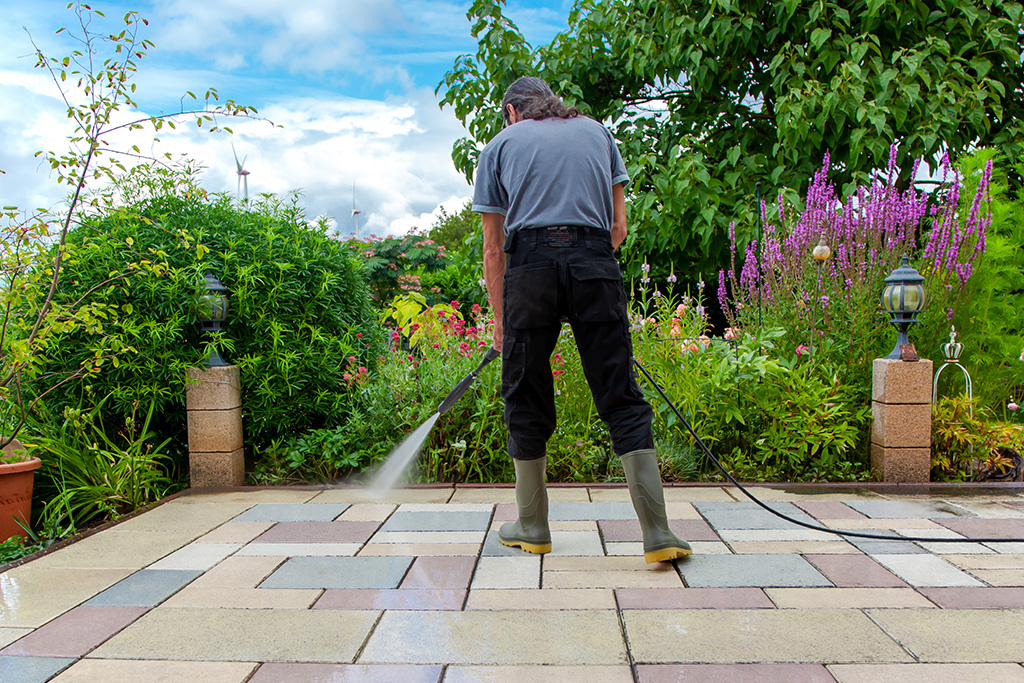
With its warmer weather, spring is a great time to have family and friends over for an outdoor party. However, your patio will likely need some attention before you can fully enjoy it. Consider renting a pressure washer to start the season with a freshly cleaned outdoor space. It can be used on wood, concrete, and brick, and you can even use it to spray down the back of the house. Now is also a good opportunity to break out and clean any patio furniture you put away for winter and perhaps even add new pieces, such as cushions, chairs, umbrellas, or lights. With a newly cleaned and decorated patio, you can better enjoy the refreshing spring weather.
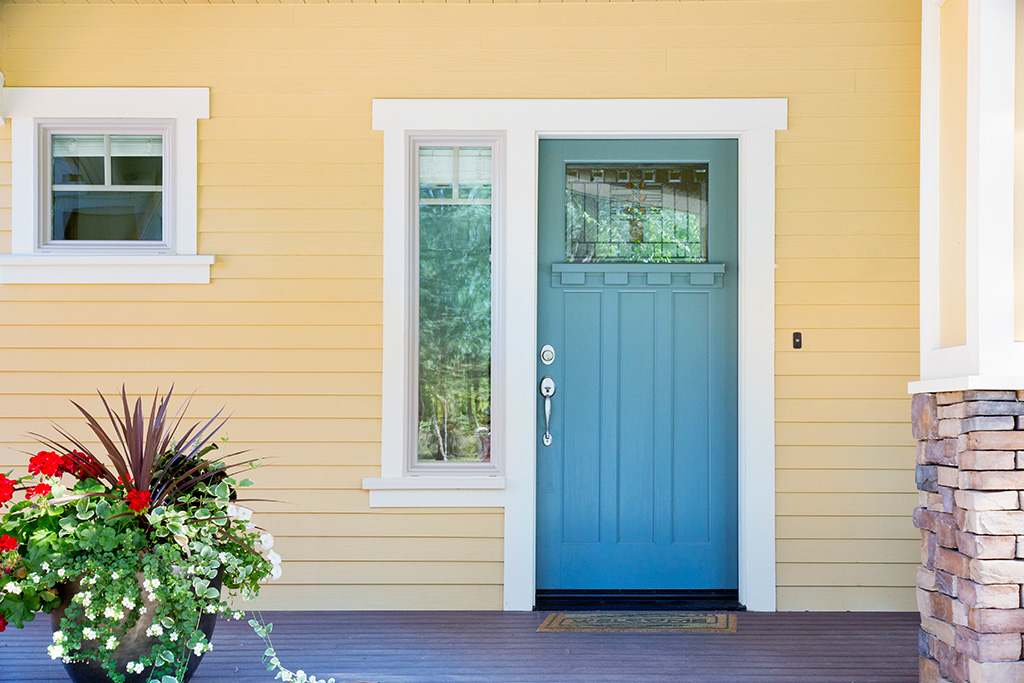
You may have hung a wreath on your front door or added some fake potted plants to your front porch for the holidays. While those are great winter touches, consider giving the area a bigger refresh this spring. You can paint your front door a new, bright color such as blue, green, or red, change out the hardware for more modern pieces, hang some fresh greenery around the porch, or update your house numbers so they’re easily visible from the street. This area is one of the first things any guest will see, so it’s worth putting in a little effort to make it stand out.
When you take the steps now to prep your home for spring, you can make the most of the beautiful weather that’s to come and fully enjoy your home’s outdoor spaces.
Hadeel Khater, co-owner of Four Rivers Studio, has passion to spare for woodwork and design. She shares the origins of the hardwood decor company she runs with her husband, the diligence behind every product, and their exciting plans for the studio.

My husband, Firas, and I have always been interested in thrifting and flipping furniture. We started casually making the occasional item for friends back in 2020. Once more and more people in our lives started reaching out for custom wood pieces, we decided to open an Etsy store to take more orders. We now have a website where people can order pieces like cutting boards, hardwood boxes, and calligraphy wall hangings that are inspired by Persian writing systems.
My husband always draws inspiration from different time periods and cultures. That’s his expertise. He’s getting a PhD as a historian from the University of Chicago. There’s an Ottoman legend that a nomad warrior had a dream of a tree bursting from his chest. Out of the tree came four rivers that each flowed in different directions across the world. This dream represented the warrior going on to found the Ottoman Empire and expand his dynasty across the world—just like the four rivers in his dream.
Firas is extremely interested in history. He recently made a cutting board out of wood that makes a gradient from light to dark. He says that piece represents a legend of the light from the creator coming down on all living things. A lot of his work is symbolic like that.
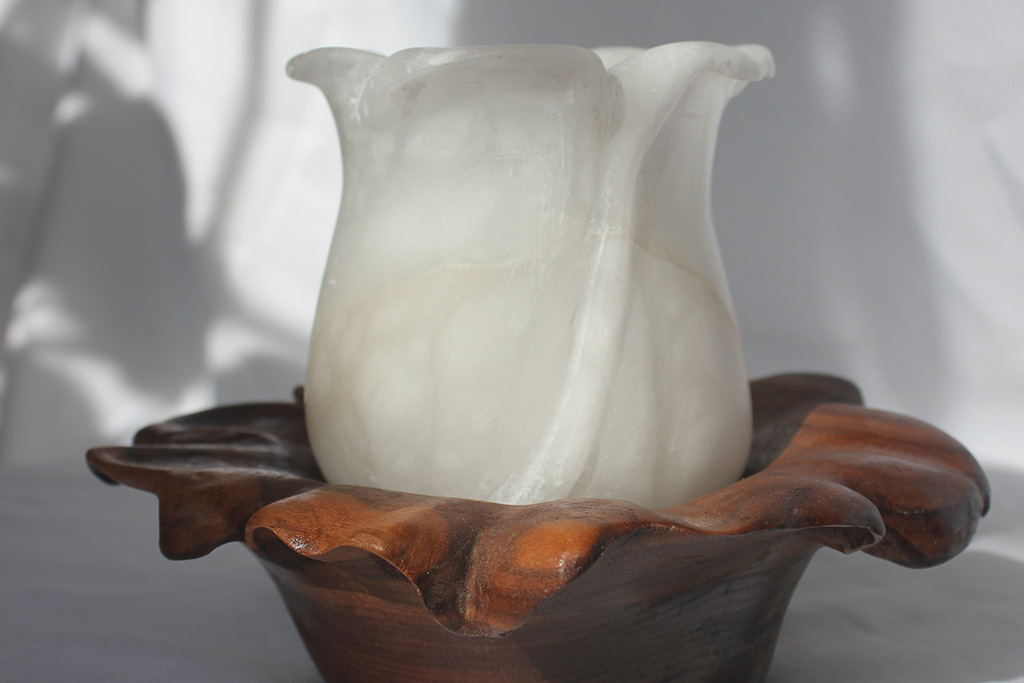
Not everything is necessarily Persian or Ottoman. Whatever I’m inspired to make at a certain time is what I decide to create, so I can’t even anticipate what I might decide to do next until the inspiration strikes me.
I’m inspired by natural materials, color combinations, interesting use of lines, and pieces that create eye-catching visual depth. I try not to emulate anyone in particular. When I get inspiration to design a piece, I avoid looking at similar woodwork or furniture and instead try to manifest my whole vision on my own.
And I don’t like making the same thing twice. My husband is more methodical. He can produce a lot of similar pieces, like our calligraphy wall hangings, based on a similar theme or symbol. I like for each project to be the product of a single vision and to have a clear thought process from beginning to end.
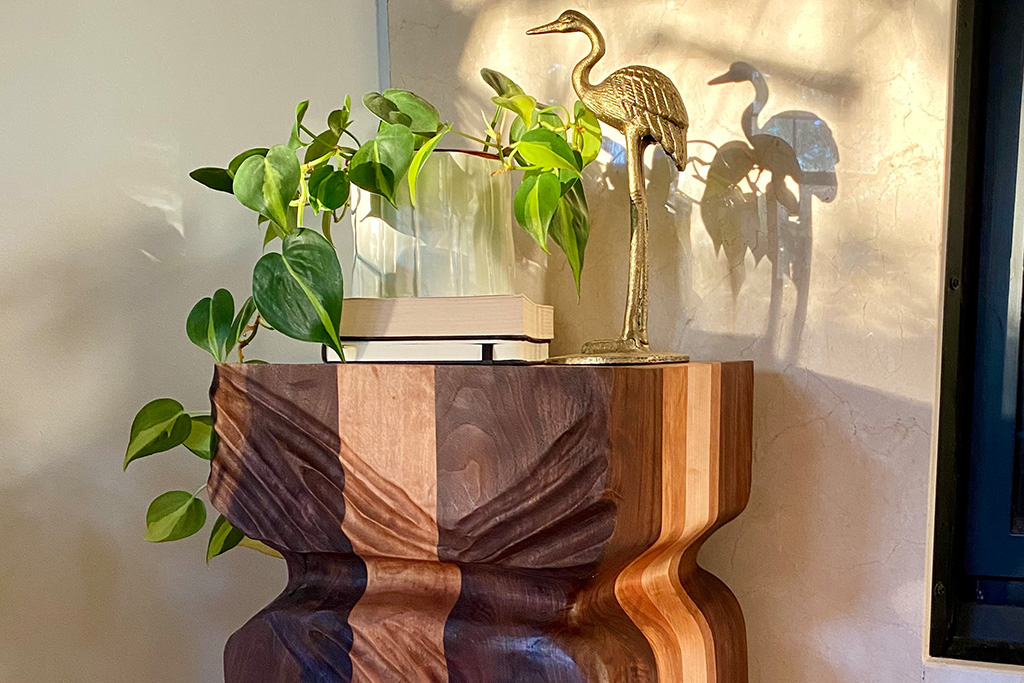
Totally. I always tell people, “You could go to a home goods store and find products like ours for less money. But you won’t get the same level of quality.” Mass-produced stuff doesn’t feature a well-thought-out design. There’s not as much consideration of the use of materials, what materials are appropriate, or how well they age—or even if they’re useful. Some of the cutting boards I see at home decor shops are made with woods that aren’t ideal for making cutting boards.
When you buy a piece from Four Rivers Studio, you aren’t just supporting us as a small business. We work full-time and have small children, and we still choose to do this work because we’re passionate about it. The passion, thought process, unique inspiration, and story behind each piece are all missing when you buy something mass made. Plus, you don’t know how sustainable their production processes are or even how well these goods support the people making them—even if the label says they’re “handmade” or “imported.”
Once I visualize what I want to make, I then have to determine which materials to use to stay true to my inspiration. It’s a little chaotic. I sketch out my design, then decide on materials of various colors and styles. What would add an accent, like wood with a lot of character or knots in it? What would be a good supplement, like a contrasting shape? I like pairing simplicity with complexity. Then I’m out in the woodworking studio either freehanding a design or feeding it through a CNC [machinery software].
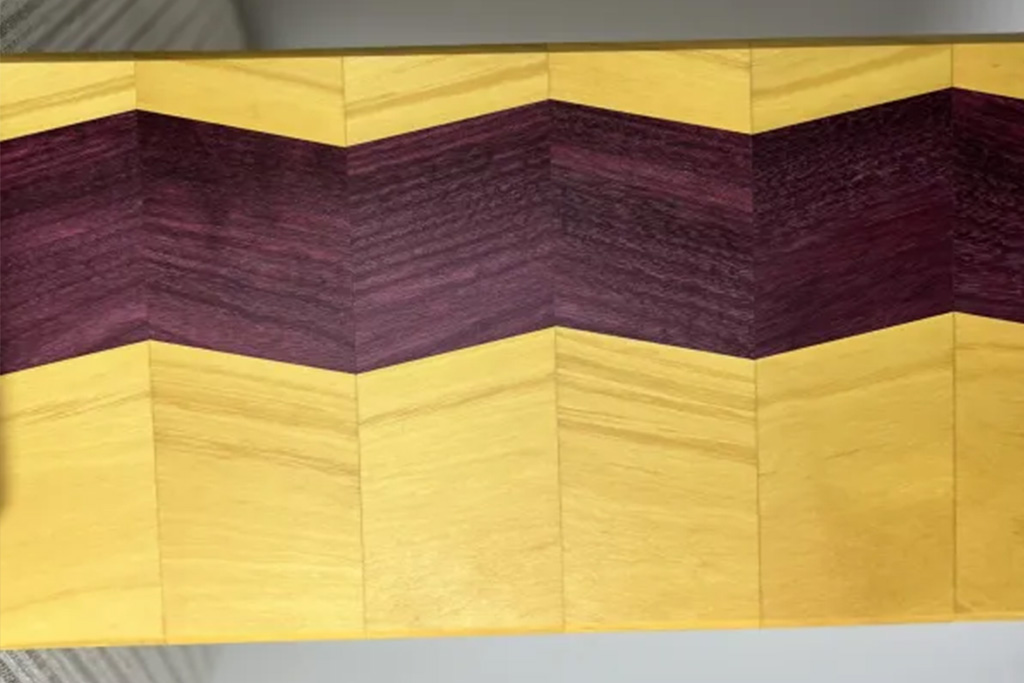
We tend to use a lot of domestic hardwood like walnut, which is so classic and naturally beautiful. But we also sometimes import wood with unique colors or patterns you can’t really find around Chicago.
I love the work of interior designers like Heidi Caillier or Carmeon Hamilton. My goal is to match the work of the Renovation Husbands. Their designs and vision are just amazing. My dream is to have our work featured in one of their projects.

I want to start making furniture and large wooden sculptures. I’m currently taking a joinery course at the Chicago School of Woodworking so I’m prepared to take on these larger pieces.
Spring can be an inspiring season, so you might be tempted to experiment with new meal ideas to refresh your routine. This pair of recipes from the Whole Food for Your Family cookbook can help you put the fun back into your family’s meals.
Chicken salad is a lunchtime staple, but this recipe puts a healthier spin on it by using creamy avocado as a replacement for mayo.
This tasty dessert is so creamy, it’s hard to believe it’s dairy-free!
Whole Food for Your Family by Autumn Michaelis. Copyright © 2022 by Autumn Michaelis. Reprinted by permission of Harvest, an imprint of HarperCollins Publishers.
recipe by autumn michaelis
photos by autumn michaelis
If chicken salad and avocado salsa had a baby, it would be this salad. My boys aren’t a fan of regular chicken salad or even avocados on their own, but they love pico de gallo. So, I started with this chunky salsa, chopped up cooked chicken, and added a hearty amount of avocado for healthy fat and texture, and voilà! My boys devoured it and loved the easy cold option for lunches. Of course, this just created the problem of Dad and the boys arm wrestling over who gets the last of it.
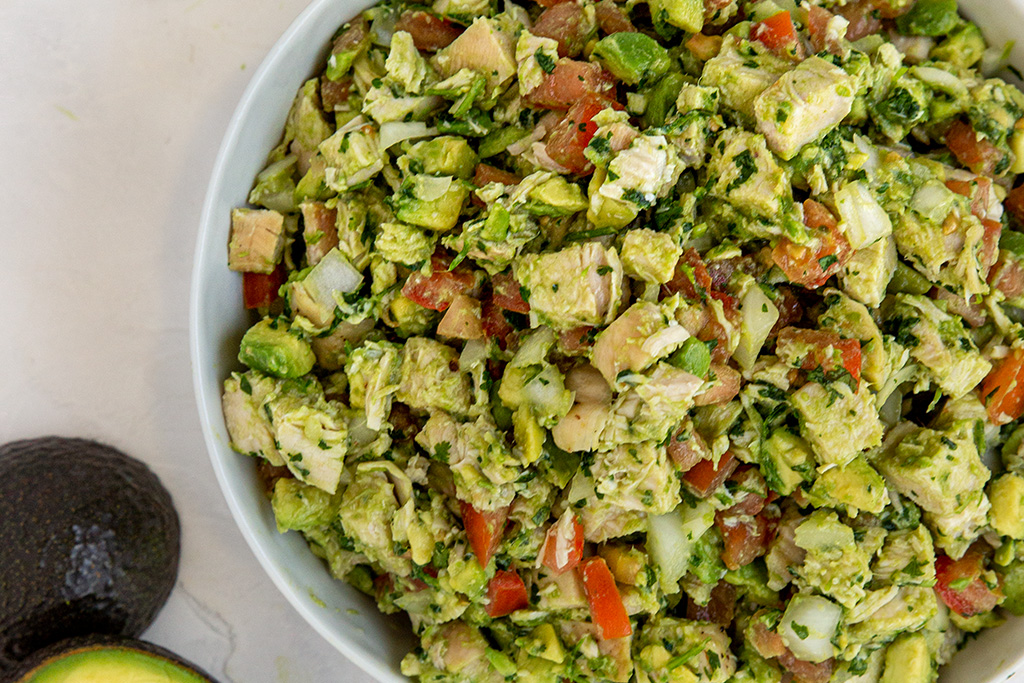
Serves 4
Note: An easy way to cook the chicken is to cut the trimmed chicken breasts into a few large pieces, rub them with olive oil (about ½ tbsp.), sprinkle with salt and pepper, and bake at 350°F for 30 minutes.
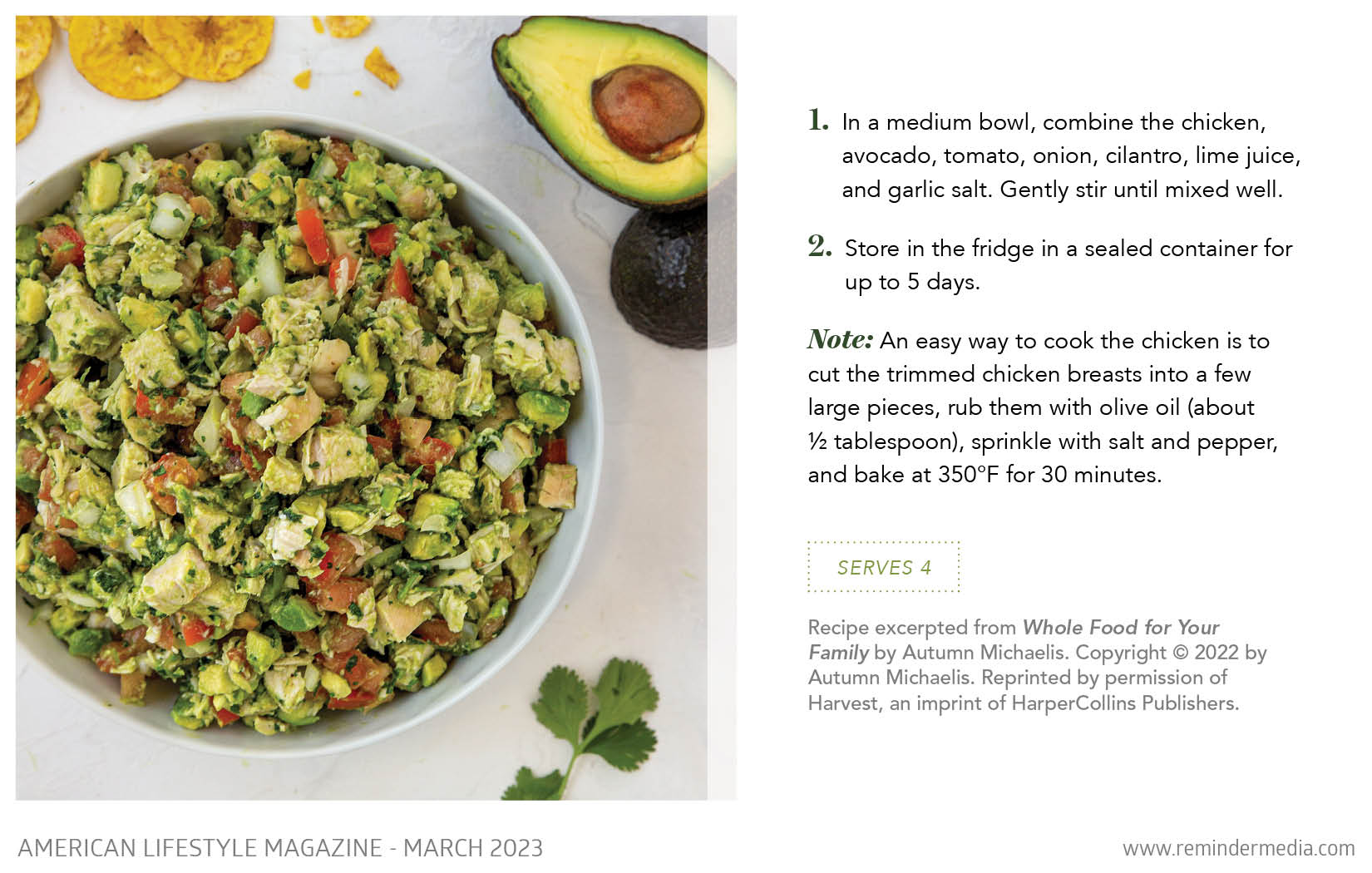



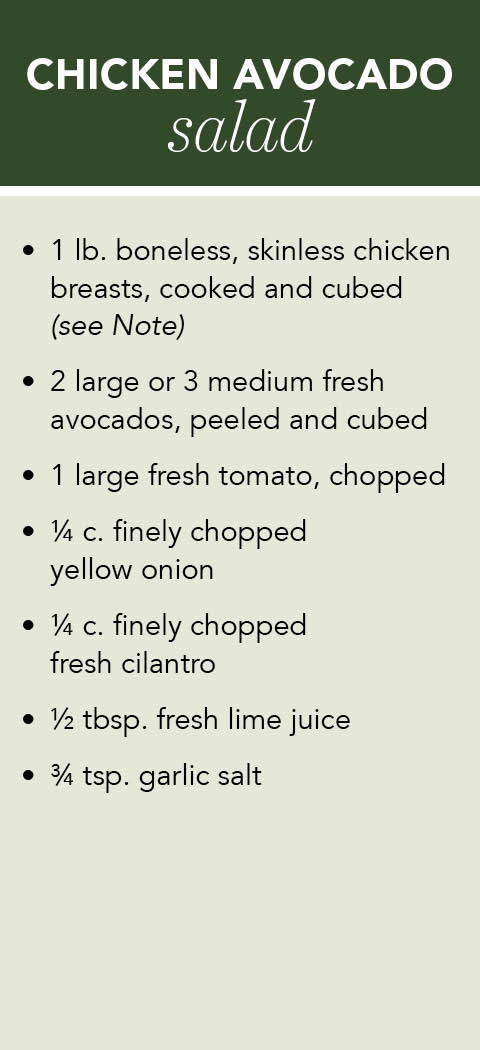
recipe by autumn michaelis
photos by autumn michaelis
Many who’ve been to the theme park known as the “Happiest Place on Earth” have had a creamy but light pineapple whip dessert. This copycat version takes only 10 minutes, with fantastic ingredients that make this treat a no-brainer YES to enjoy.
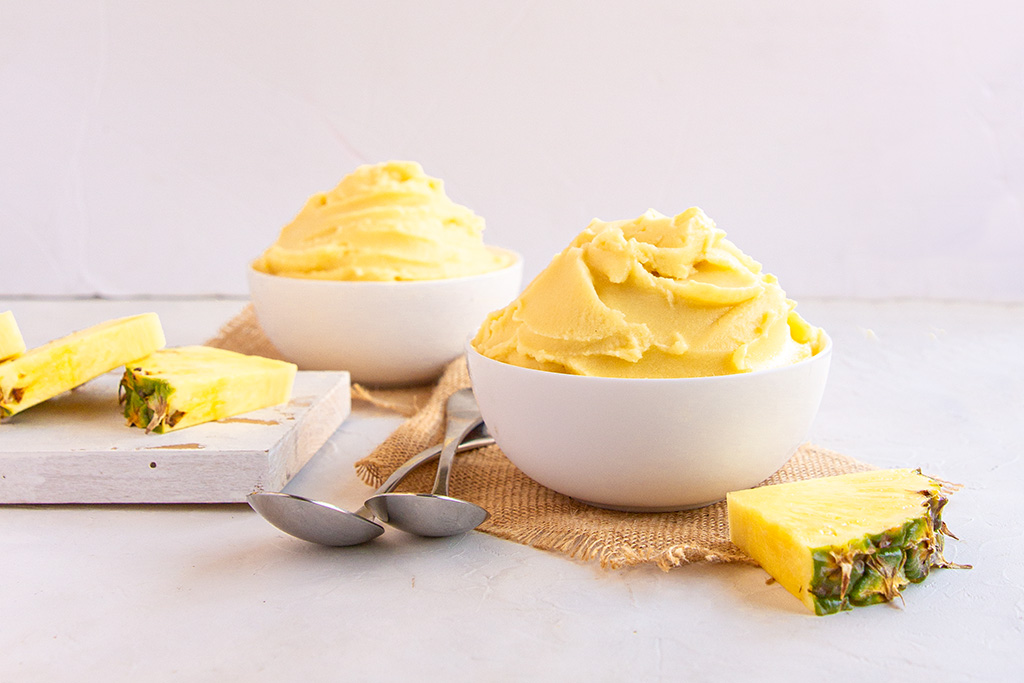
Serves 2
In a blender or food processor, combine the pineapple, milk, honey, and vanilla and blend until completely smooth. The mixture will be thick—don’t be tempted to add more milk, or the whip will be too thin. Enjoy immediately for a soft-serve texture. For a thicker texture, transfer the mixture to an ice cream maker, and mix for 5 minutes or freeze the mixture for 30 minutes before enjoying. If it’s been in the freezer for more than 30 minutes, let it sit out on the counter for 20 to 30 minutes to thaw before scooping.
Note: I prefer using coconut milk in this because of its rich texture, but you can use whatever dairy-free milk works for your family. You can also use 1 banana instead of the honey for sweetness.





Golf has been one of America’s most popular leisure activities for decades, and certain areas of the country have become synonymous with the sport—especially in the Southeast. Places like Hilton Head Island, South Carolina, Virginia Beach, and Augusta, Georgia, are just a few of the area’s uberpopular destinations.
But if you veer off a little to the west, you’ll also find a piece of golf heaven in the great state of Alabama. The Robert Trent Jones Golf Trail, named after the famed course architect, traverses the state from north to south. It offers 468 holes on 26 courses at 11 sites and, much like the state itself, has something for everybody.

The visionary behind the trail is Dr. David G. Bronner, A University of Alabama law school and PhD graduate. Bronner is also the longtime head of the Retirement Systems of Alabama (RSA), which funds the state’s public pensions. In 1980, he came up with an ambitious plan with a dual purpose—build an array of Alabama golf courses that would not only draw people to the state and boost its economy but also create a steady stream of revenue for those who benefit from the RSA.
But he needed to partner with someone who could design his courses. Enter Robert Trent Jones Sr.
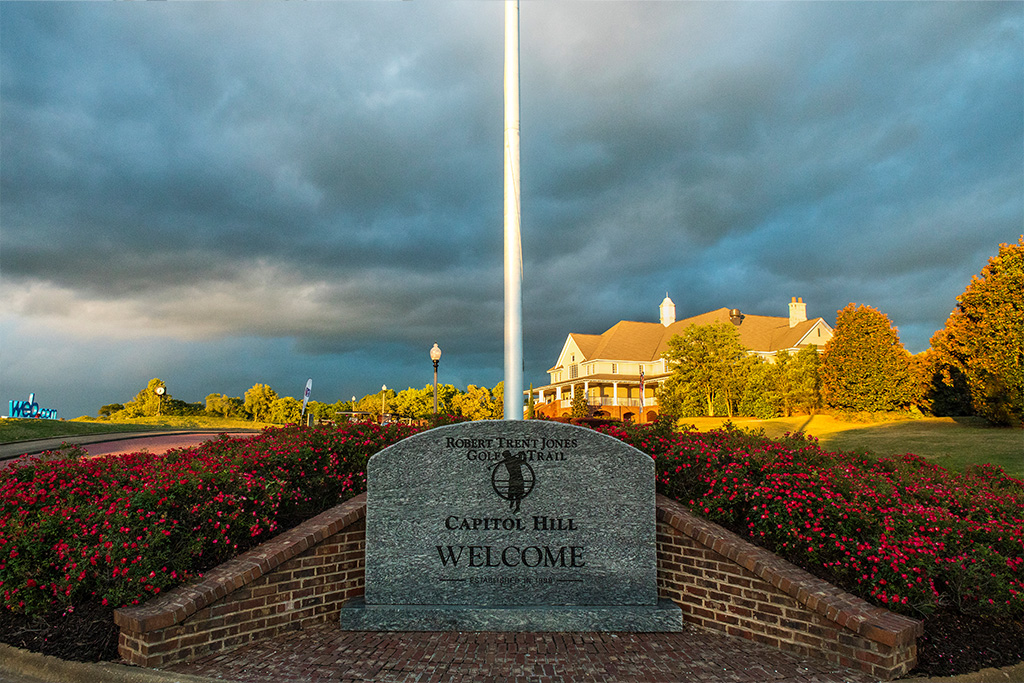
By the time this project was conceived, its titular architect was in semiretirement. The World Golf Hall of Famer had already designed or redesigned over five hundred courses around the world by that time, so he didn’t need to add to his resume. But he jumped at the opportunity to have an entire state—especially one like Alabama, which offers a myriad of landscapes—as a blank canvas. Bronner, Jones, and their respective teams worked together to make the Robert Trent Jones Golf Trail, the largest golf-construction project ever, a reality. Eight courses were opened by 1999, and three more were added between 2004 and 2005 after Jones had passed away.
The venture has been a major success, with golfers from all over the world having played an estimated twelve million rounds—about a half million rounds per year—since the RTJ Trail opened. But there’s more than golf along the way. You can tackle multiple courses while also enjoying the amenities at the several high-quality hotels, restaurants, shops, and spas strategically located across the state at each leg of the trail. With these funds, the RTJ Trail is able to not only turn a profit but also provide income to both the state’s pension funds and its tourism revenue, the latter of which soared to over $24 billion in 2022.

When you travel to Alabama to take on this golf trail, expect your game to be tested: the longest hole length is over 700 yards, and the longest course is around 8,200 yards. Here’s an overview of each site, listed from north to south, to help you make your plans.
The Shoals, Muscle Shoals (36 holes)
If you like your links long, then the Shoals’ Fighting Joe course may be for you: it’s over 8,000 demanding yards, including a massive 716-yard hole.
Hampton Cove, Huntsville (54 holes)
One of Hampton Cove’s three courses is unique because it has zero bunkers—the only Jones-designed course in the world that’s bunker-free.
Silver Lakes, Anniston/Gadsden (36 holes)
All you really need to know about Silver Lakes is that it has courses named Backbreaker, Mindbreaker, and Heartbreaker.
Oxmoor Valley, Birmingham (54 holes)
Crafted in the Appalachian Mountains, Oxmoor is both scenic and, thanks to its wildly undulating elevations, quite challenging.

Ross Bridge, Hoover (18 holes)
Popular with golfers and golf editors alike, this jaw-dropping course—a mere five minutes from Oxmoor Valley—is the fifth largest in the world, topping out at 8,191 yards, and even boasts an 80-foot waterfall.
Grand National, Auburn/Opelika (54 holes)
Golf World readers named this must-play course the top public golf facility in the entire country.
Capitol Hill, Prattville (54 holes)
Coming right behind Grand National, Capitol Hill nabbed the number two spot nationally from Golf World readers.
Cambrian Ridge, Greenville (36 holes)
Cambrian Ridge is as challenging as it is scenic, and it hosts its popular Father/Son Championship each May.

Highland Oaks, Dothan (36 holes)
If you head to Highland Oaks, keep your driver handy—one of its courses, Marshwood, challenges you with a staggering 701-yard, par-5 hole.
Magnolia Grove, Mobile (54 holes)
Magnolia’s eighteen-hole courses are more player friendly, including its par-3 course, which Golf Digest named the best of its kind in the country in 2020.
Lakewood Club, Point Clear (36 holes)
The southernmost course on the RTJ Trail, Lakewood is also its most historical: it originally opened in 1947 and was later purchased and renovated by the RSA.

Always innovating, the Robert Trent Jones Trail opened a new course at Oxmoor Valley last year, The Back Yard. With a par-3, nine-hole layout, it’s designed for a casual, unique golf experience—complete with firepits and rocking chairs but without water hazards and golf carts. Stress goes out the window at the Back Yard, where the hole yardage ranges from a mere 59 yards to 132 yards.
Alabama may not be the first destination you think of when it comes to world-class golf, but it should be. Schedule your tee times for the Robert Trent Jones Golf Trail, and you’ll have a links adventure for the ages.
